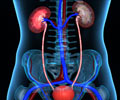PKD1 gene is found to be the key factor in the development of several forms of polycystic kidney and liver disease.

The most common form of this condition is called autosomal dominant polycystic kidney disease (ADPKD), a condition passed on to children from one parent affected with the disease that is found in 600,000 people in the United States alone. Two genes, PKD1 and PKD2, are responsible for the onset of this condition.
PKD patients also develop cysts of the liver and Somlo and colleagues had previously identified families with identical cysts found only in the liver. They found two different genes were responsible for this related condition.
The researchers wanted to know how liver-only polycystic disease was related to ADPKD. In a series of experiments using both genetically engineered mouse models and biochemical studies, they found that the activity of only one of the four genes, PKD1, controlled cyst formation in the other forms of the disease. Experiments in mice showed that modulating dosage of PKD1 could slow disease progression.
"The data suggest the exciting possibility that targeting the activity of PKD1 may be beneficial for treatment of isolated polycystic liver disease, childhood recessive polycystic kidney disease and even a subset of adult ADPKD," said Somlo.
Yale is a leader in the investigation of PKD. For instance basic scientific research conducted at Yale has been crucial in helping to identify cilia, the tiny thread-like structure that extends from a cell's surface, as a critical component in cyst forming pathways. Yale has been the home of one of the four NIH-funded national centers of excellence in PKD research since 1999. In addition, the laboratory of Craig Crews, Lewis B. Cullman Professor of Molecular, Cellular, and Developmental Biology and Professor of Chemistry and of Pharmacology, has identified a compound that has shown promise in reducing number of cysts in some mouse models of PKD.
Source-Eurekalert









